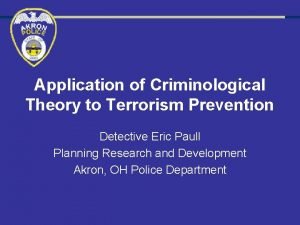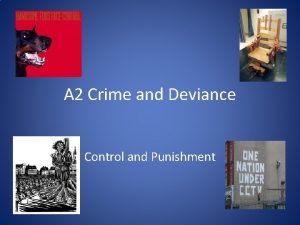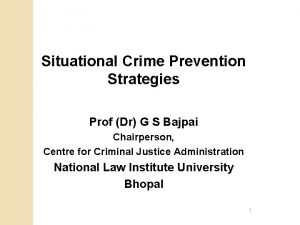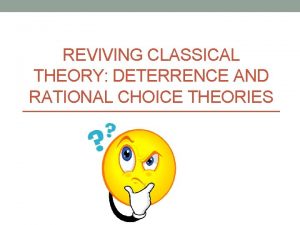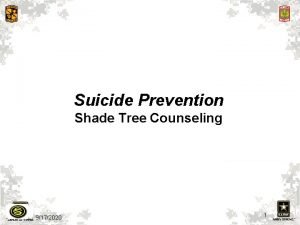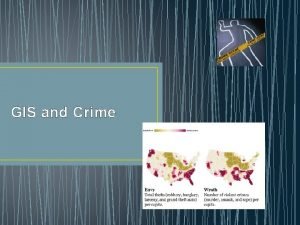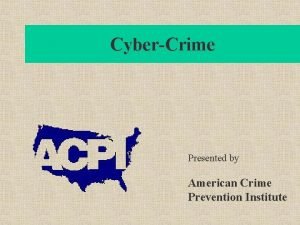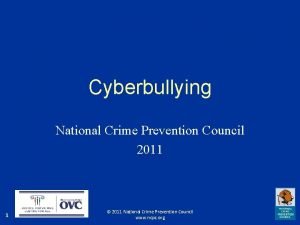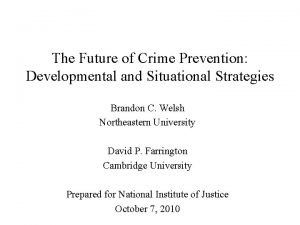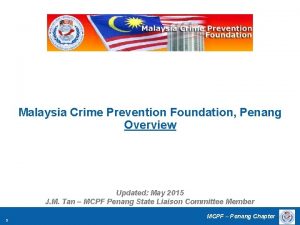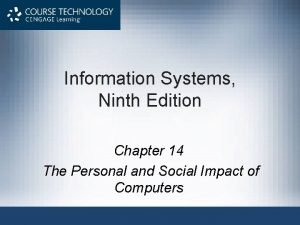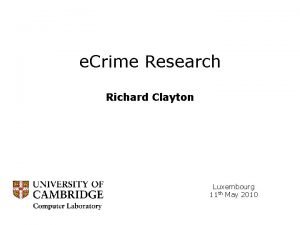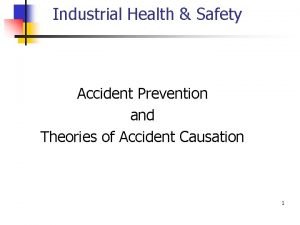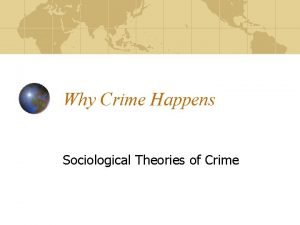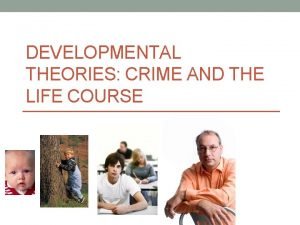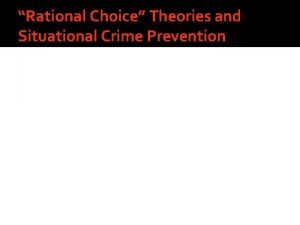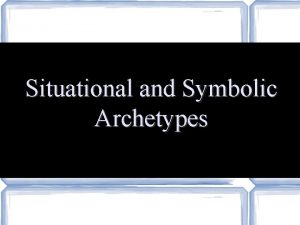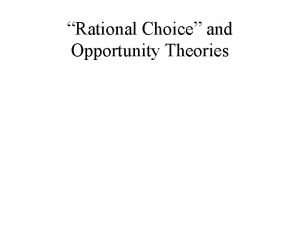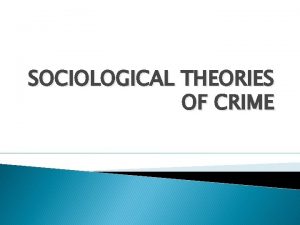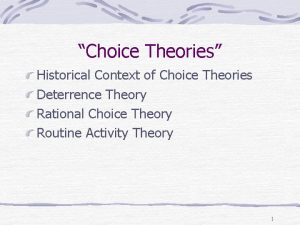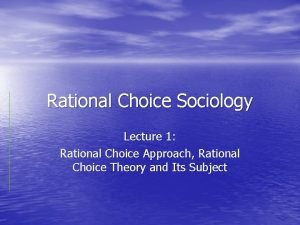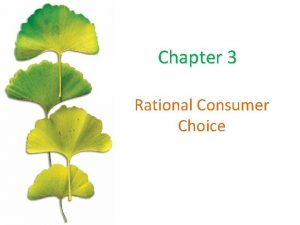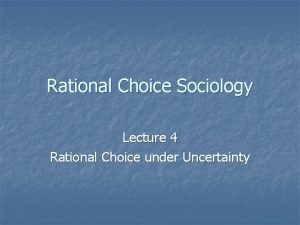Rational Choice Theories and Situational Crime Prevention Rational


















- Slides: 18

“Rational Choice” Theories and Situational Crime Prevention

“Rational Choice Theory” n Economics (language, theory) q q “Expected Utility” = calculation of all risks and rewards Note: This is much broader than deterrence n n Includes risks not associated with criminal justice Same assumptions as deterrence theory q q Human nature = rational, calculating, hedonistic This is because “economic theory” (supply/demand, rational consumers) has same “classical school” roots

Rationality Assumption n How “RATIONAL” is the offender? q PURE = only expected utility (rational calculation of risk/reward) matters n q Few, if any, take this position LIMITED = then, what else matters? n CORNISH AND CLARKE good example

Cornish and Clarke (1986) n Crime as a Rational Choice q q Criminal Involvement: the decision to engage in crime (versus other activity) Criminal Event: factors that influence the decision to commit a specific crime

Criminal Involvement n Choices to become involved in crime, to continue in crime, and to desist from crime q q Each (involvement, continuance, desistence) need separate explanation Involvement decisions are multistage and multifactor, extending over long time periods

Example of factors that explain initial involvement: Background Factors q temperament, intelligence, cognitive style, sex, class, education, neighborhood, broken home… Previous experience q Direct and vicarious learning, moral attitudes, selfperception, foresight and planning Solutions evaluated q Degree of effort, amount/immediacy of reward, likelihood and severity of punishment, moral costs

Criticisms What happened to our “rational” offender guided by “free will? ” q q q In their models, rational thinking and free will are very constrained/limited Not much different from other theories of crime n Borrow liberally from learning theory, psychology, social control theory… At what point does their theory cease to be a “rational choice” model and start to become a learning, social control, IQ theory of crime?

Example of Continuance in Burglary Increased Professionalism q pride in skills, reduce risk (better planning), acquire fencing contacts, skill in dealing with criminal justice system Changes in Lifestyle and Values q choose work to facilitate burglaries, enjoy “life in fast lane, ” devalue legitimate work Changes in Peer group q lose contact with prosocial friends, labeled as criminal, quarrels with family. . .

The Criminal Event n Focus on predictors of specific crimes, look at immediate (situational) factors q n Area q n e. g. , what might lead a person to commit a burglaries in middle class neighborhood? Easily accessible, few police patrols, low security Home q anyone home? , especially wealthy, detached, bushes/other cover, dog, security system. . .

Evaluating Rational Choice n Empirical Support? q Criminal Involvement n q Criminal Event n n n Ethnographic research suggests limited (if any) rational reasoning or weighing of costs/benefits. Ethnographic research somewhat supportive, but many crimes suggest limited appraisals. Parsimony and Scope? Policy Implication?

Routine Activities Theory n n Cohen and Felson (1979): “Crime and Everyday Life” Crime as the Convergence in Time and Space of Three Factors 1. Motivated Offenders (typically ignored) 2. Suitable Targets 3. Lack of Capable Guardianship n Scope: “Direct-Contact Predatory Crimes” q Felson in 1990 s extended to white collar crime, drug crime

Motivated offenders taken for granted n Assumption is that they are always present q n Criticized for this (really a theory of crime? ) Really explains “victimization” or the “criminal event” q Similar to Cornish and Clarke in that respect

Suitable Targets n Value ($, ability to fence) q n n n Some universal ($) some dependent upon offenders environment Visibility (sights and sounds) Inertia (why autos are victimized, high tech movement) Access (cul-de-sac vs open-ended street, garage parking vs. street parking)

Lack of Capable Guardianship n Protection from police? ? q n Informal social control q n n Less emphasis in this over time “…not usually someone who brandishes a gun or threatens an offender with quick punishment, but rather someone whose mere presence serves as a gentle reminder that someone is looking. ” Strength in numbers Time spent at home

Evaluating Routine Activities Theory n Empirical Support q q n Household activity ratio related to crime Criminal “Hotspots” within high crime areas Prison Studies (% time outside of cell) Victimization Studies Criticism? Confirming common sense.

Environmental Criminology and Situational Crime Prevention and n Environmental Criminology q n An umbrella term (catch-all) to describe opportunity theories that focus on the criminal event (e. g. , routine activity theory) Situational Crime Prevention q A policy implication of routine activities/RCT (not a specific theory)

Policy Implications Deterrence vs. Environmental Crim n In deterrence theory, if the CJS (e. g. , threat of arrest/imprisonment) is not effective, the only other option is incapacitation. q n This has been the preferred U. S. strategy Environmental Criminology suggests that we can remove or limit the opportunity to offend q q This has been the preferred strategy in the UK Benefit of this approach over incapacitation? ?

Examples of Situational Crime Prevention (Ronald n Increase Clarke) the perceived effort of crime q q n Increase perceived risks of crime q q n Target hardening (better window locks) Control access to targets (electronic access to parking garage) Natural surveillance (street lights, defensible space) Formal surveillance (red light/speed cameras) Reduce anticipated rewards of crime q q Reduce targets (removable car radios, women’s refuges) Deny benefits (prompt graffiti cleaning)
 Situational crime prevention definition
Situational crime prevention definition Ron clarke 1992
Ron clarke 1992 25 situational crime prevention techniques
25 situational crime prevention techniques Primary prevention secondary prevention tertiary prevention
Primary prevention secondary prevention tertiary prevention Rational choice theory key concepts
Rational choice theory key concepts Shadetree army
Shadetree army 4 d's of crime prevention
4 d's of crime prevention Crimegis
Crimegis American crime prevention institute
American crime prevention institute National crime prevention council cyberbullying
National crime prevention council cyberbullying Youth desk saps
Youth desk saps Developmental crime prevention
Developmental crime prevention Mcpf penang
Mcpf penang Crime prevention 9th edition
Crime prevention 9th edition Cyber crime prevention luxembourg
Cyber crime prevention luxembourg Human factors theory
Human factors theory Sociological theories of crime
Sociological theories of crime Modern biological theories of crime
Modern biological theories of crime Developmental criminology
Developmental criminology
